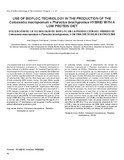Mostrar el registro sencillo del ítem
Use of biofloc technology in the production of the Colossoma macropomum x Piaractus brachypomus hybrid with a low protein diet
| dc.rights.license | http://creativecommons.org/licenses/by-nc-sa/3.0/ve/ | es_VE |
| dc.contributor.author | Rodríguez, José Gregorio | |
| dc.contributor.author | Cristina, Valencia Zuhelen | |
| dc.contributor.author | Poleo, German Antonio | |
| dc.date.accessioned | 2020-11-28T18:07:08Z | |
| dc.date.available | 2020-11-28T18:07:08Z | |
| dc.date.issued | 2020 | |
| dc.identifier.issn | 0798-2259 | |
| dc.identifier.uri | http://www.saber.ula.ve/handle/123456789/47119 | |
| dc.description.abstract | The present study was carried out to observe the performance of the hybrid Colossoma macropomum x Piaractus brachypomus, when cultured in a Biofloc system. Six hundred fingerling with a mean weight of 3.3 ± 0.4 grams (g), were randomly distributed into six concrete tanks (22 fish/m3). Three randomly selected tanks were routinely supplemented with molasses, as an extra source of carbohydrate (Mol) and the other three were only given feed (Feed) containing 28% protein, during 154 days. Water quality parameters such as: dissolved oxygen, total ammonia nitrogen, nitrite, nitrate, alkalinity, hardness and pH were in the accepted range for the specie in both treatments. Significance differences in final weigh, growth rate and final density were observed (P < 0.05) between treatments. In Mol treatment, fish grew to a final weight of 332.16 ± 79 g, a feed conversion ratio of 1.27 ± 0.06 and a survival rate of 97%. In Feed treatment, fish grew to a final weigh of 290.28 ± 72 g, a feed conversion ratio of 1.31 ± 0.06 and a survival rate of 93%. This work showed that the hybrid of C. macropomum x P. brachypomus can be grown in biolfoc systems without affecting its production yield. | es_VE |
| dc.language.iso | es | es_VE |
| dc.publisher | SaberULA | es_VE |
| dc.rights | info:eu-repo/semantics/openAccess | es_VE |
| dc.subject | Biofloc | es_VE |
| dc.subject | Colossoma macropomum | es_VE |
| dc.subject | Piaractus brachypomus | es_VE |
| dc.subject | Híbrido | es_VE |
| dc.title | Use of biofloc technology in the production of the Colossoma macropomum x Piaractus brachypomus hybrid with a low protein diet | es_VE |
| dc.title.alternative | Utilización de la tecnología de Biofloc en la producción del híbrido de Colossoma macropomum x Piaractus brachypomus, con una dieta baja en proteína | es_VE |
| dc.type | info:eu-repo/semantics/article | es_VE |
| dcterms.dateAccepted | 15/12/2019 | |
| dcterms.dateSubmitted | 15/03/2020 | |
| dc.description.abstract1 | El presente estudio evaluó el desempeño del hibrido de Colossoma macropomum x Piaractus brachypomus cultivado en un sistema de Biofloc. Seiscientos alevines con un peso promedio de 3.3 ± 0.4 gramos (g), se distribuyeron al azar en seis tanques de concreto (22 peces/m3) con un volumen de 4000 litros de agua. Duarte 154 días, tres tanques, seleccionados al azar, fueron suplementados con melaza, como fuente extra de carbohidratos (Mol) y los otros tres solo se les suministró alimento (Feed) que contenía 28% de proteína. Parámetros de la calidad del agua como: oxígeno disuelto, amonio total, nitritos, nitratos, alcalinidad, dureza y pH estuvieron en el rango aceptable para el híbrido de cachama. Se observaron diferencias significativas entre los tratamientos en el peso final, en la tasa de crecimiento y en la densidad final de cultivo (P < 0.05). En el tratamiento Mol, los peces crecieron hasta un peso final de 332.16 ± 79 g, una conversión alimenticia de 1.27 ± 0.06 y una tasa de sobrevivencia del 97%. En el tratamiento, Feed, los peces crecieron hasta un peso final de 290.28 ± 72 g, una conversión alimenticia de 1.31 ± 0.06 y tasa de sobrevivencia del 93%. Este trabajo mostró que el hibrido de C. macropomum x P. brachypomus puede ser producido en sistemas de biofloc sin afectar su rendimiento. | es_VE |
| dc.description.colacion | 42-48 | es_VE |
| dc.description.email | gpoleo@ucla.edu.ve | es_VE |
| dc.identifier.depositolegal | pp199102ZU46 | |
| dc.identifier.edepositolegal | ppi201502ZU4665 | |
| dc.identifier.eissn | 2477-944X | |
| dc.publisher.pais | Venezuela | es_VE |
| dc.subject.institucion | Universidad del Zulia (LUZ) | es_VE |
| dc.subject.institucion | Universidad de Los Andes (ULA) | es_VE |
| dc.subject.keywords | Biofloc | es_VE |
| dc.subject.keywords | Colossoma macropomum | es_VE |
| dc.subject.keywords | Piaractus brachypomus | es_VE |
| dc.subject.keywords | Hybrid | es_VE |
| dc.subject.publicacionelectronica | Revista Científica | |
| dc.subject.seccion | Revista Científica: Vida Silvestre | es_VE |
| dc.subject.thematiccategory | Medio Ambiente | es_VE |
| dc.subject.tipo | Revistas | es_VE |
| dc.type.media | Texto | es_VE |
Ficheros en el ítem
Este ítem aparece en la(s) siguiente(s) colección(ones)
-
Revista Científica - 2020 - Vol.XXX - Nº 001
Enero - Marzo 2020


